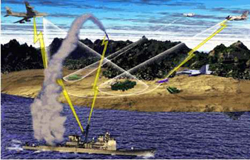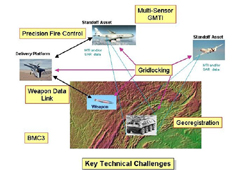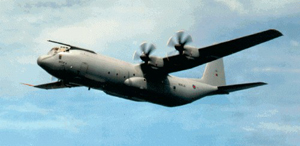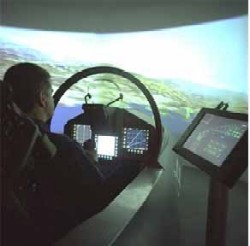Daily News
by Gail Helmer
[ Send Us News | Archives ]
Naval Warfare Project V14.2 has been posted along with Fleet Command V1.34 Mega Patch.The FC V1.34 is now direct downloadable from the NWP Section.
Rogue Spear Training U.S. Soldiers
Ubi Soft Entertainment has agreed to allow LB&B Associates Inc. to adopt the game engine used in the best-selling Red Storm game Tom Clancy's Rainbow Six Rogue Spear, to help train U.S. soldiers. The game engine will enable the Department of Defense to train military personnel in how to conduct military operations in urban terrain. The engine, which was developed in Red Storm Entertainment's North Carolina studio, will not be used for weapons training. Instead the government wants to use the high-tech system to help hone decision-making skills at the small-unit level.
"We've looked at all of the first person shooters on the market, and no game engine comes close to the realism of Tom Clancy's Rogue Spear," said Michael S. Bradshaw, Systems Division Manager of LB&B Associates Inc. "We need to train the elements of the small-unit on how to prepare for a mission, how to work as a team during mission execution, and how to conduct after action debriefs, and this engine will let us do that and more."
The engine will be modified to conform to the maps and scenarios requested by the military. It should be training military personnel within six months. LB&B Associates Inc. will show off the technology at the annual conference for "Warfighting Readiness Through Innovative Training Technology" (I/ITSEC) in Orlando, Florida, November 26-29.
SWAT 3 Tactical Game of the Year Edition
Sierra today announced its third installment in its SWAT 3series, SWAT 3: Tactical Game of the Year Edition, scheduled to reach shelves late September. This special two-CD edition includes new missions, 10-person multiplayer capabilities, and an Advanced Tactics CD containing instructional SWAT training videos, a Q&A tactics section, and much more--all provided by actual SWAT officers.
Sierra will be releasing a SWAT 3 version 2.0 update that will give owners of Close Quarters Battle and Elite Edition all of the features of the new Tactical Game of the Year Edition (except for the materials contained on the Advanced Tactics CD). The 2.0 update includes 10-man multiplayer game play, enhanced AI, the option to play as an element leader or be commanded by an AI element leader, and the newly enhanced Scenario Editor. Version 2.0 will also be available in late September.
Amazon.com Launches Online Computer Store
Amazon.com has announced today their new online computer store, despite the PC industry's dismal outlook. Amazon will be offering machines made by Apple, Compaq, Hewlett-Packard, IBM and Toshiba. Continuing its shift to act as the platform for online sales while letting other companies handle inventory, Amazon is partnering with Ingram Micro Inc, the No. 1 distributor of computer products, to handle logistics and shipping. Amazon will also sell refurbished computers through a handful of partners, collecting a commission on each sale, executives said.
A Northrop Grumman Corporation team successfully engaged a moving vehicle yesterday with a low-cost, precision weapon as part of a contract to develop an Affordable Moving Surface Target Engagement (AMSTE) capability for the Department of Defense. The test took place at the Eglin AFB test range.
The purpose of the $12 million AMSTE program is to develop a system that locates and tracks a ground target moving at up to 50 m.p.h. and destroys it with an affordable precision weapon.
"This technology makes it possible for commanders to conduct multiple, near-simultaneous, stand-off precision engagements of even the most mobile targets in all weather," said Bill McCall, senior program manager at Integrated Systems. "We have designed an open architecture that will work with multiple intelligence, surveillance and reconnaissance platforms, multiple attack platforms and multiple weapons and still be compatible with current command and control systems, using established message sets, procedures and communications links." "With this capability, we'll be able to find and follow those targets that are trying to evade detection and destroy them with little collateral damage, effectively denying the enemy sanctuary of movement," he said.

The test was designed to couple Integrated Systems' Joint Surveillance Target Attack Radar System precision ground moving target indicator (GMTI) with a Joint Strike Fighter (JSF) active electronically-scanned array radar with precision GMTI capability. The JSF candidate radar, developed by Northrop Grumman Electronic Systems in Baltimore for the Lockheed Martin/Northrop Grumman/BAE SYSTEMS JSF team, was mounted on a company-owned BAC I-II test-bed aircraft.
Real-time precision tracking and engagement data was gathered by each radar and used to direct a low-cost, precision weapon produced by Lockheed Martin Missile and Fire Control of Orlando, Fla. The weapon was launched from an Air Force F-16 and dropped on a moving target on the Eglin range.
The Northrop Grumman AMSTE solution complements the Air Force's Concept of Operations for the Time Critical Targeting (TCT) Cell. The TCT Cell is designed to automate and integrate the kill chain process against targets that, to a large extent, are "time critical" because of their movement. The AMSTE solution provides a commander with many of the capabilities needed to operate like a weapon system against these targets by addressing the critical engagement period that extends from target nomination through weapon impact.
Specifically, AMSTE provides the TCT Cell with the ability to ensure that the moving targets it nominates will be precisely targeted. Additionally, AMSTE makes it possible for these movers to be targeted from a standoff distance, in all weather conditions, and while using low-cost weapons.
With the addition of AMSTE, joint forces will possess the capability to defeat anti-access threats and make the "halt phase" an ideal means for defeating aggression quickly at minimum risk for U.S. personnel.
C-130J-30 Begins Paratroop Testing
Lockheed Martin has begun a joint test program with the U.S. Air Force and the U.S. Army to validate the C-130J-30 for paratroop airdrop operations. The tests are being conducted by the Airborne and Special Operations Test Directorate at Fort Bragg N.C. They are being flown out of Pope Air Force Base N.C., home of the 43rd Airlift Wing.
During the next several weeks the aircraft will drop up to 92 paratroops at a time to demonstrate the ability of the C-130J-30 to safely deploy paratroops from both sides of the aircraft. In addition, rapid ground evacuation of the aircraft with up to 128 troops will be carried out. Deployment of paratroopers at high altitude from each side door and the ramp of the aircraft was demonstrated during the Edwards AFB phase of testing.

"This is an intense program with both the Army and the Air Force to validate the aircraft for the critical airdrop mission," said Ross Reynolds, Lockheed Martin's C-130J program vice president. "The C-130 has always been the Army's preferred jump platform, and we are looking forward to the Army seeing just how much more capable the new C-130J-30 is."
The C-130J-30 is central to the modernization that is underway with the U.S. Army. With the need for rapid, flexible deployment and sustainment, one of the key acquisition parameters for new systems is focused on the requirement for them to fit in a C-130J-30. No other aircraft offers the combined flexibility of strategic deployment of troops and armor, and as well as intratheater, austere environment tactical operations.
The C-130J-30's sophisticated navigation system allows the aircrew to achieve highly accurate drops in all weather conditions. The C-130J-30 brings a new level of operational airdrop capability to both the Air Force as operator and the Army as end user. Current analyses show a close formation of 33 C-130J-30s will be able to drop 2,800 troops in less than five minutes.
Luftwaffe To Get Eurofighter Interim Training Device
NETMA, the four-nation Eurofighter customer agency and Eurofighter GmbH have signed a contract for development and procurement of the Interim Training Device (ITD), a tool to support future operational aircrew transition to the Eurofighter when it enters service with the Luftwaffe. It will be installed at the German Air Force Fighter Wing (Jagdgeschwader) JG 73 "Steinhoff" at Laage near Rostock.

Responsibility for ITD as a fore-runner to the full mission training simulator ASTA (Aircrew Synthetic Training Aids) lies with EADS Military Aircraft, which will integrate and deliver the ITD system by the middle of next year. First application will be at EADS Military Aircraft in Manching, for initial service-instructor training, with transfer to JG 73 together with the first batch of aircraft in 2003.
The Eurofighter ITD for Luftwaffe consists of a fully functional cockpit facsimile equipped with MK16A ejection seat replica, HOTAS, rudder/brake pedals, and all multi-function head-up and head-down displays, control panels and switches. The simulation elements at delivery represent the complete Eurofighter aircraft models (flight, aero, mass, flight control system, sensors, engines etc.) and the avionics systems (e.g., CAPTOR radar and Infrared Search & Track Sensor/IRST, weapons).
The ITD can train future Eurofighter pilots not only in handling, flight characteristics, operational and emergency procedures, but also supplies five different tactical scenarios.
As weapon system company EADS will ensure full consistency of data and characteristics between the real Eurofighter flying weapon system and the training tool, and will ensure consistency and continuity with the future ASTA full mission simulators.
The ITD visual system consists of a high-resolution three-channel unit permitting a field of vision with 150 degrees in azimuth and 40 degrees in elevation. As the conversion training for JG 73 starts in Manching and will be continued at Laage, both bases including their surrounding airspaces (100 by 100 kilometres each) are simulated.
There is also an integrated instructor/operator station (IOS), from where the progress of the student pilot will be monitored and from where environmental and operational inputs can be generated and malfunctions injected into the training session. The IOS, in combination with a data recording system with access to all data used in the ITD, will also be used for briefing, debriefing and for reconstructing the training mission profiles.
LV100-5 Engine Testing For ACCE Programme
GE and Honeywell have entered the test phase of the LV100-5 turboshaft engine development activity as part of the US Army's Abrams-Crusader Common Engine (ACCE) programme. The LV100-5 engine was selected last year by the Army to power both the General Dynamics M1 Abrams tank and the United Defense Crusader self-propelled howitzer, based on the engine's light weight, high reliability, low operating costs and full Abrams-Crusader commonality.

The Army expects to realize savings of more than $5 billion in operating and support costs as the result of re-engining approximately 2,800 M1 Abrams tanks with the LV100-5 engine. In the case of the Crusader self-propelled howitzer, powering with the LV100-5 rather than a diesel-fuelled engine will reduce overall vehicle weight by more than three tons without compromising mission capability.
Testing of several engine components, including the inlet system, the combustor and the power turbine diffuser, is under way. In addition, full engine testing of an LV100-2, modified to simulate unique features of the Abrams-Crusader LV100-5 engine, has begun. Testing of the first complete LV100-5 engine is scheduled to begin in mid-2002, followed by intense vehicle testing on both the Abrams tank and the Crusader howitzer.
Overall development of the LV100-5 is managed by a GE/Honeywell team. Within the team, Honeywell's specific responsibilities include the design and manufacture of the compressor, recuperator, auxiliary gearbox and control system, while GE Aircraft Engines has responsibility for design and manufacture of the combustor, high-pressure turbine and power turbine.
Production of the LV100-5 is scheduled to begin in 2004.
[ Send Us News | Archives ]
by Gail Helmer
Wednesday August 29, 2001
- Naval Warfare Project V14.2 Released
- Rogue Spear Training U.S. Soldiers
- SWAT 3 Tactical Game of the Year Edition
- Amazon.com Launches Online Computer Store
- Successful AMSTE Test Scores Bullseye
- C-130J-30 Begins Paratroop Testing
- Luftwaffe To Get Eurofighter Interim Training Device
- LV100-5 Engine Testing For ACCE Programme
PC News
Naval Warfare Project V14.2 ReleasedNaval Warfare Project V14.2 has been posted along with Fleet Command V1.34 Mega Patch.The FC V1.34 is now direct downloadable from the NWP Section.
Rogue Spear Training U.S. Soldiers
Ubi Soft Entertainment has agreed to allow LB&B Associates Inc. to adopt the game engine used in the best-selling Red Storm game Tom Clancy's Rainbow Six Rogue Spear, to help train U.S. soldiers. The game engine will enable the Department of Defense to train military personnel in how to conduct military operations in urban terrain. The engine, which was developed in Red Storm Entertainment's North Carolina studio, will not be used for weapons training. Instead the government wants to use the high-tech system to help hone decision-making skills at the small-unit level.
"We've looked at all of the first person shooters on the market, and no game engine comes close to the realism of Tom Clancy's Rogue Spear," said Michael S. Bradshaw, Systems Division Manager of LB&B Associates Inc. "We need to train the elements of the small-unit on how to prepare for a mission, how to work as a team during mission execution, and how to conduct after action debriefs, and this engine will let us do that and more."
The engine will be modified to conform to the maps and scenarios requested by the military. It should be training military personnel within six months. LB&B Associates Inc. will show off the technology at the annual conference for "Warfighting Readiness Through Innovative Training Technology" (I/ITSEC) in Orlando, Florida, November 26-29.
SWAT 3 Tactical Game of the Year Edition
Sierra today announced its third installment in its SWAT 3series, SWAT 3: Tactical Game of the Year Edition, scheduled to reach shelves late September. This special two-CD edition includes new missions, 10-person multiplayer capabilities, and an Advanced Tactics CD containing instructional SWAT training videos, a Q&A tactics section, and much more--all provided by actual SWAT officers.
Sierra will be releasing a SWAT 3 version 2.0 update that will give owners of Close Quarters Battle and Elite Edition all of the features of the new Tactical Game of the Year Edition (except for the materials contained on the Advanced Tactics CD). The 2.0 update includes 10-man multiplayer game play, enhanced AI, the option to play as an element leader or be commanded by an AI element leader, and the newly enhanced Scenario Editor. Version 2.0 will also be available in late September.
Amazon.com Launches Online Computer Store
Amazon.com has announced today their new online computer store, despite the PC industry's dismal outlook. Amazon will be offering machines made by Apple, Compaq, Hewlett-Packard, IBM and Toshiba. Continuing its shift to act as the platform for online sales while letting other companies handle inventory, Amazon is partnering with Ingram Micro Inc, the No. 1 distributor of computer products, to handle logistics and shipping. Amazon will also sell refurbished computers through a handful of partners, collecting a commission on each sale, executives said.
Military News
Successful AMSTE Test Scores BullseyeA Northrop Grumman Corporation team successfully engaged a moving vehicle yesterday with a low-cost, precision weapon as part of a contract to develop an Affordable Moving Surface Target Engagement (AMSTE) capability for the Department of Defense. The test took place at the Eglin AFB test range.
The purpose of the $12 million AMSTE program is to develop a system that locates and tracks a ground target moving at up to 50 m.p.h. and destroys it with an affordable precision weapon.

"This technology makes it possible for commanders to conduct multiple, near-simultaneous, stand-off precision engagements of even the most mobile targets in all weather," said Bill McCall, senior program manager at Integrated Systems. "We have designed an open architecture that will work with multiple intelligence, surveillance and reconnaissance platforms, multiple attack platforms and multiple weapons and still be compatible with current command and control systems, using established message sets, procedures and communications links." "With this capability, we'll be able to find and follow those targets that are trying to evade detection and destroy them with little collateral damage, effectively denying the enemy sanctuary of movement," he said.

The test was designed to couple Integrated Systems' Joint Surveillance Target Attack Radar System precision ground moving target indicator (GMTI) with a Joint Strike Fighter (JSF) active electronically-scanned array radar with precision GMTI capability. The JSF candidate radar, developed by Northrop Grumman Electronic Systems in Baltimore for the Lockheed Martin/Northrop Grumman/BAE SYSTEMS JSF team, was mounted on a company-owned BAC I-II test-bed aircraft.
Real-time precision tracking and engagement data was gathered by each radar and used to direct a low-cost, precision weapon produced by Lockheed Martin Missile and Fire Control of Orlando, Fla. The weapon was launched from an Air Force F-16 and dropped on a moving target on the Eglin range.
The Northrop Grumman AMSTE solution complements the Air Force's Concept of Operations for the Time Critical Targeting (TCT) Cell. The TCT Cell is designed to automate and integrate the kill chain process against targets that, to a large extent, are "time critical" because of their movement. The AMSTE solution provides a commander with many of the capabilities needed to operate like a weapon system against these targets by addressing the critical engagement period that extends from target nomination through weapon impact.
Specifically, AMSTE provides the TCT Cell with the ability to ensure that the moving targets it nominates will be precisely targeted. Additionally, AMSTE makes it possible for these movers to be targeted from a standoff distance, in all weather conditions, and while using low-cost weapons.
With the addition of AMSTE, joint forces will possess the capability to defeat anti-access threats and make the "halt phase" an ideal means for defeating aggression quickly at minimum risk for U.S. personnel.
C-130J-30 Begins Paratroop Testing
Lockheed Martin has begun a joint test program with the U.S. Air Force and the U.S. Army to validate the C-130J-30 for paratroop airdrop operations. The tests are being conducted by the Airborne and Special Operations Test Directorate at Fort Bragg N.C. They are being flown out of Pope Air Force Base N.C., home of the 43rd Airlift Wing.
During the next several weeks the aircraft will drop up to 92 paratroops at a time to demonstrate the ability of the C-130J-30 to safely deploy paratroops from both sides of the aircraft. In addition, rapid ground evacuation of the aircraft with up to 128 troops will be carried out. Deployment of paratroopers at high altitude from each side door and the ramp of the aircraft was demonstrated during the Edwards AFB phase of testing.

"This is an intense program with both the Army and the Air Force to validate the aircraft for the critical airdrop mission," said Ross Reynolds, Lockheed Martin's C-130J program vice president. "The C-130 has always been the Army's preferred jump platform, and we are looking forward to the Army seeing just how much more capable the new C-130J-30 is."
The C-130J-30 is central to the modernization that is underway with the U.S. Army. With the need for rapid, flexible deployment and sustainment, one of the key acquisition parameters for new systems is focused on the requirement for them to fit in a C-130J-30. No other aircraft offers the combined flexibility of strategic deployment of troops and armor, and as well as intratheater, austere environment tactical operations.
The C-130J-30's sophisticated navigation system allows the aircrew to achieve highly accurate drops in all weather conditions. The C-130J-30 brings a new level of operational airdrop capability to both the Air Force as operator and the Army as end user. Current analyses show a close formation of 33 C-130J-30s will be able to drop 2,800 troops in less than five minutes.
Luftwaffe To Get Eurofighter Interim Training Device
NETMA, the four-nation Eurofighter customer agency and Eurofighter GmbH have signed a contract for development and procurement of the Interim Training Device (ITD), a tool to support future operational aircrew transition to the Eurofighter when it enters service with the Luftwaffe. It will be installed at the German Air Force Fighter Wing (Jagdgeschwader) JG 73 "Steinhoff" at Laage near Rostock.

Responsibility for ITD as a fore-runner to the full mission training simulator ASTA (Aircrew Synthetic Training Aids) lies with EADS Military Aircraft, which will integrate and deliver the ITD system by the middle of next year. First application will be at EADS Military Aircraft in Manching, for initial service-instructor training, with transfer to JG 73 together with the first batch of aircraft in 2003.
The Eurofighter ITD for Luftwaffe consists of a fully functional cockpit facsimile equipped with MK16A ejection seat replica, HOTAS, rudder/brake pedals, and all multi-function head-up and head-down displays, control panels and switches. The simulation elements at delivery represent the complete Eurofighter aircraft models (flight, aero, mass, flight control system, sensors, engines etc.) and the avionics systems (e.g., CAPTOR radar and Infrared Search & Track Sensor/IRST, weapons).
The ITD can train future Eurofighter pilots not only in handling, flight characteristics, operational and emergency procedures, but also supplies five different tactical scenarios.
As weapon system company EADS will ensure full consistency of data and characteristics between the real Eurofighter flying weapon system and the training tool, and will ensure consistency and continuity with the future ASTA full mission simulators.
The ITD visual system consists of a high-resolution three-channel unit permitting a field of vision with 150 degrees in azimuth and 40 degrees in elevation. As the conversion training for JG 73 starts in Manching and will be continued at Laage, both bases including their surrounding airspaces (100 by 100 kilometres each) are simulated.
There is also an integrated instructor/operator station (IOS), from where the progress of the student pilot will be monitored and from where environmental and operational inputs can be generated and malfunctions injected into the training session. The IOS, in combination with a data recording system with access to all data used in the ITD, will also be used for briefing, debriefing and for reconstructing the training mission profiles.
LV100-5 Engine Testing For ACCE Programme
GE and Honeywell have entered the test phase of the LV100-5 turboshaft engine development activity as part of the US Army's Abrams-Crusader Common Engine (ACCE) programme. The LV100-5 engine was selected last year by the Army to power both the General Dynamics M1 Abrams tank and the United Defense Crusader self-propelled howitzer, based on the engine's light weight, high reliability, low operating costs and full Abrams-Crusader commonality.

The Army expects to realize savings of more than $5 billion in operating and support costs as the result of re-engining approximately 2,800 M1 Abrams tanks with the LV100-5 engine. In the case of the Crusader self-propelled howitzer, powering with the LV100-5 rather than a diesel-fuelled engine will reduce overall vehicle weight by more than three tons without compromising mission capability.
Testing of several engine components, including the inlet system, the combustor and the power turbine diffuser, is under way. In addition, full engine testing of an LV100-2, modified to simulate unique features of the Abrams-Crusader LV100-5 engine, has begun. Testing of the first complete LV100-5 engine is scheduled to begin in mid-2002, followed by intense vehicle testing on both the Abrams tank and the Crusader howitzer.
Overall development of the LV100-5 is managed by a GE/Honeywell team. Within the team, Honeywell's specific responsibilities include the design and manufacture of the compressor, recuperator, auxiliary gearbox and control system, while GE Aircraft Engines has responsibility for design and manufacture of the combustor, high-pressure turbine and power turbine.
Production of the LV100-5 is scheduled to begin in 2004.
